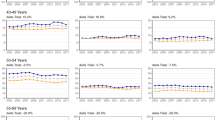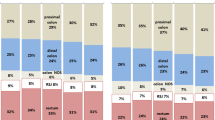Abstract
Purpose
Data on the incidence of colorectal cancer (CRC) is conflicting, and it is unknown if the incidence is constant, declining, or increasing. Proximal colon cancer is considered to be more common among older individuals, but recent data have shown that rectal cancer and distal colon cancer have been increasing in the younger population. The aim of this study was to determine the trends regarding CRC incidence and tumour location in Sweden.
Methods
CRC statistics from the National Board of Health and Welfare 1995–2015 were used. CRC incidence rates by age group (< 50 years, 50–79 years, ≥ 80 years), sex, and tumour localisation (proximal colon, distal colon, or rectum) were calculated and analysed using Poisson regression.
Results
The age-standardised incidence of CRC increased in Sweden during the study period. This increase was significant (P < 0.0001) for colon cancer during the study period for all age groups regardless of tumour localisation. The greatest increase (27–52% per decade) in the colon cancer incidence rate was seen among men and women < 50 years of age. The incidence rate for rectal cancer increased for men < 50 years (P < 0.0001), decreased for both men and women aged ≥ 80 years (P < 0.005), and did not change for the remaining groups.
Conclusions
The CRC incidence in Sweden, in particular colon cancer, is increasing regardless of tumour localisation for individuals < 50 years of age. This paper supports the implementation of population-based colorectal cancer screening. A diagnostic workup should be performed in symptomatic individuals < 50 years of age.

Similar content being viewed by others
References
Inra JA, Syngal S (2015) Colorectal cancer in young adults. Dig Dis Sci 60(3):722–733. https://doi.org/10.1007/s10620-014-3464-0
Gandhi J, Davidson C, Hall C, Pearson J, Eglinton T, Wakeman C, Frizelle F (2017) Population-based study demonstrating an increase in colorectal cancer in young patients. Br J Surg 104(8):1063–1068. https://doi.org/10.1002/bjs.10518
O'Connell JB, Maggard MA, Livingston EH, Yo CK (2004) Colorectal cancer in the young. Am J Surg 187(3):343–348. https://doi.org/10.1016/j.amjsurg.2003.12.020
Patel P, De P (2016) Trends in colorectal cancer incidence and related lifestyle risk factors in 15-49-year-olds in Canada, 1969-2010. Cancer Epidemiol 42:90–100. https://doi.org/10.1016/j.canep.2016.03.009
Siegel RL, Jemal A, Ward EM (2009) Increase in incidence of colorectal cancer among young men and women in the United States. Cancer Epidemiol Biomark Prev 18(6):1695–1698. https://doi.org/10.1158/1055-9965.Epi-09-0186
Young JP, Win AK, Rosty C, Flight I, Roder D, Young GP, Frank O, Suthers GK, Hewett PJ, Ruszkiewicz A, Hauben E, Adelstein BA, Parry S, Townsend A, Hardingham JE, Price TJ (2015) Rising incidence of early-onset colorectal cancer in Australia over two decades: report and review. J Gastroenterol Hepatol 30(1):6–13. https://doi.org/10.1111/jgh.12792
Favoriti P, Carbone G, Greco M, Pirozzi F, Pirozzi RE, Corcione F (2016) Worldwide burden of colorectal cancer: a review. Updat Surg 68(1):7–11. https://doi.org/10.1007/s13304-016-0359-y
Torre LA, Bray F, Siegel RL, Ferlay J, Lortet-Tieulent J, Jemal A (2015) Global cancer statistics, 2012. CA Cancer J Clin 65(2):87–108. https://doi.org/10.3322/caac.21262
Welch HG, Robertson DJ (2016) Colorectal cancer on the decline--why screening can’t explain it all. N Engl J Med 374(17):1605–1607. https://doi.org/10.1056/NEJMp1600448
SCRCR (2016) Tjock- och ändtarmscancer - Nationellt vårdprogram. Swedish Colorectal Cancer Registry
Thorn M, Bergstrom R, Kressner U, Sparen P, Zack M, Ekbom A (1998) Trends in colorectal cancer incidence in Sweden 1959-93 by gender, localization, time period, and birth cohort. Cancer Causes Control 9(2):145–152
Larsen IK, Bray F (2010) Trends in colorectal cancer incidence in Norway 1962-2006: an interpretation of the temporal patterns by anatomic subsite. Int J Cancer 126(3):721–732. https://doi.org/10.1002/ijc.24839
Chauvenet M, Cottet V, Lepage C, Jooste V, Faivre J, Bouvier AM (2011) Trends in colorectal cancer incidence: a period and birth-cohort analysis in a well-defined French population. BMC Cancer 11:282. https://doi.org/10.1186/1471-2407-11-282
Aravani A, Downing A, Thomas JD, Lagergren J, Morris EJA, Hull MA (2018) Obesity surgery and risk of colorectal and other obesity-related cancers: an English population-based cohort study. Cancer Epidemiol 53:99–104. https://doi.org/10.1016/j.canep.2018.01.002
Folkhalsomyndigheten (2018) Övervikt och fetma. https://www.folkhalsomyndigheten.se/folkhalsorapportering-statistik/folkhalsans-utveckling/levnadsvanor/overvikt-och-fetma/
Friedenreich C, Norat T, Steindorf K, Boutron-Ruault MC, Pischon T, Mazuir M, Clavel-Chapelon F, Linseisen J, Boeing H, Bergman M, Johnsen NF, Tjonneland A, Overvad K, Mendez M, Quiros JR, Martinez C, Dorronsoro M, Navarro C, Gurrea AB, Bingham S, Khaw KT, Allen N, Key T, Trichopoulou A, Trichopoulos D, Orfanou N, Krogh V, Palli D, Tumino R, Panico S, Vineis P, Bueno-de-Mesquita HB, Peeters PH, Monninkhof E, Berglund G, Manjer J, Ferrari P, Slimani N, Kaaks R, Riboli E (2006) Physical activity and risk of colon and rectal cancers: the European prospective investigation into cancer and nutrition. Cancer Epidemiol Biomark Prev 15(12):2398–2407. https://doi.org/10.1158/1055-9965.Epi-06-0595
Larsson SC, Wolk A (2006) Meat consumption and risk of colorectal cancer: a meta-analysis of prospective studies. Int J Cancer 119(11):2657–2664. https://doi.org/10.1002/ijc.22170
Taggarshe D, Rehil N, Sharma S, Flynn JC, Damadi A (2013) Colorectal cancer: are the “young” being overlooked? Am J Surg 205(3):312–316; discussion 316. https://doi.org/10.1016/j.amjsurg.2012.10.016
Koo S, Neilson LJ, Von Wagner C, Rees CJ (2017) The NHS Bowel Cancer Screening Program: current perspectives on strategies for improvement. Risk Manag Healthc Policy 10:177–187. https://doi.org/10.2147/rmhp.S109116
Dozois EJ, Boardman LA, Suwanthanma W, Limburg PJ, Cima RR, Bakken JL, Vierkant RA, Aakre JA, Larson DW (2008) Young-onset colorectal cancer in patients with no known genetic predisposition: can we increase early recognition and improve outcome? Medicine 87(5):259–263. https://doi.org/10.1097/MD.0b013e3181881354
Cheng L, Eng C, Nieman LZ, Kapadia AS, Du XL (2011) Trends in colorectal cancer incidence by anatomic site and disease stage in the United States from 1976 to 2005. Am J Clin Oncol 34(6):573–580. https://doi.org/10.1097/COC.0b013e3181fe41ed
Chouhan H, Ferrandon S, DeVecchio J, Kalady MF, Church JM (2018) A changing spectrum of colorectal cancer biology with age: implications for the young patient. Dis Colon rectum. https://doi.org/10.1097/dcr.0000000000001188
Brändstedt J, Wangefjord S, Nodin B, Gaber A, Manjer J, Jirstrom K (2012) Gender, anthropometric factors and risk of colorectal cancer with particular reference to tumour location and TNM stage: a cohort study. Biol Sex Differ 3(1):23. https://doi.org/10.1186/2042-6410-3-23
Larsson SC, Wolk A (2007) Obesity and colon and rectal cancer risk: a meta-analysis of prospective studies. Am J Clin Nutr 86(3):556–565. https://doi.org/10.1093/ajcn/86.3.556
Kune GA, Kune S, Watson LF (1990) Body weight and physical activity as predictors of colorectal cancer risk. Nutr Cancer 13(1–2):9–17. https://doi.org/10.1080/01635589009514041
Author information
Authors and Affiliations
Corresponding author
Ethics declarations
Conflict of interest
The authors declare that they have no conflicts of interests.
Additional information
Publisher’s note
Springer Nature remains neutral with regard to jurisdictional claims in published maps and institutional affiliations.
Rights and permissions
About this article
Cite this article
Gutlic, I., Schyman, T., Lydrup, ML. et al. Increasing colorectal cancer incidence in individuals aged < 50 years—a population-based study. Int J Colorectal Dis 34, 1221–1226 (2019). https://doi.org/10.1007/s00384-019-03312-3
Accepted:
Published:
Issue Date:
DOI: https://doi.org/10.1007/s00384-019-03312-3




